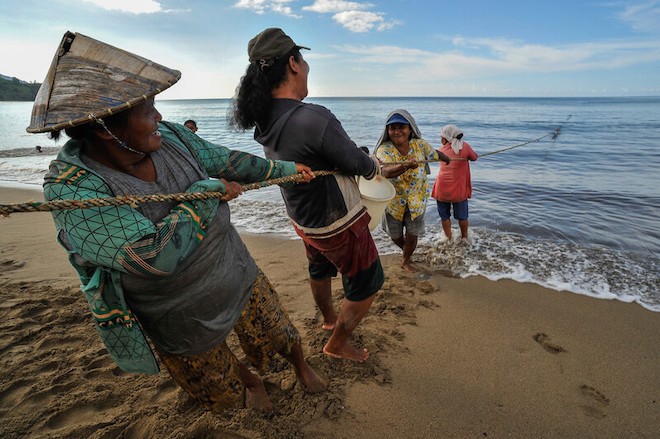
This article is published in collaboration with Arup.
Coastal environments are vital for human existence, yet only 15% of the world’s coastal areas are ecologically intact.
Nature-based solutions have immense potential to restore coastlines and benefit the environment, communities and organizations but there is work to be done to realize their full potential. The ideal coastal infrastructure project is resilient to nature’s most powerful forces, while also minimizing environmental damage locally and broadly through a low-carbon footprint. Through our work and research, we focus on one more element: How can coastal infrastructure enhance the local environment and help reverse climate change?
This is where we believe nature-based solutions hold immense potential. While nature-based solutions are currently less well understood than traditional hard infrastructure approaches, we expect they will play a significant role in creating a more sustainable future.
Innovative measures for resilient coastal environments
Coastal nature-based solutions are interventions designed with nature to restore ecosystems, reverse biodiversity loss, manage water quality, and tackle the negative effects of climate change on infrastructure and society. In coastal engineering, nature-based solutions aim to resolve the degradation and vulnerability of coastal environments through restoring the ecosystem functions of natural coastal systems such as dunes, wetlands, and mangroves. Their goal in coastal engineering is to reduce environmental harm introduced by hard infrastructure and create positive environmental, social, and economic outcomes.
First Nations peoples are the originators of nature-based solutions. Their knowledge has been passed down for generations and has helped them adapt to environmental changes and maintain sustainable practices. Guided by this knowledge, coastal management approaches can mitigate the effects of climate change and prioritize community-led solutions and community well-being.
Examples of innovative coastal resilience measures we have proposed and implemented on projects include:
- TetraPOT mangroves for enhancing coastal defence and restoring fisheries.
- Living seawalls and other habitat creation measures to improve the biodiversity of existing and new structures.
- Native intertidal vegetation as an alternative to conventional engineered solutions for shoreline erosion protection.
- Protective gabions to facilitate natural establishment of mangroves on riverbanks.
Concepts we are exploring include:
- Creating natural habitats around offshore wind farm infrastructure.
- Bringing biodiversity to typically industrial areas such as wharves and ports.
We are also co-authoring guidelines to support ecological enhancement. Working with Natural Resources Wales, we are providing guidelines to improve coastal biodiversity in coastal structures. For the Ecostructure Project, an interdisciplinary European research project exploring building ecologically sensitive design into artificial coast structures, we compiled research outputs from a 5-year project into a useful guide for practitioners.
Benefits of natural interventions to projects
The benefits of these solutions to water-based and infrastructure projects are far reaching for the environment, communities, and organizations.
Environmental benefits range from local ecosystem regeneration, improved water quality, increased species diversity, and carbon sequestration through carbon embodied in the roots and vegetation of plants, and biomass within retained soil. Other benefits include soil retention through root growth which reduces erosion and sedimentation thereby improving stability and water quality. When nature-based solutions are implemented on a larger scale, these effects can contribute to reversing biodiversity loss and mitigating and adapting to climate change. For example, a community-based mangrove restoration project in Mikoko Pamoja, Kenya, conserves 2,500 tonnes of carbon each year from avoided degradation and new planting.
Community benefits include strengthened resilience from climate shocks and stressors, a healthier local environment, more attractive landscape, increased availability of clean water, food security, and improved aquaculture opportunities.
Almost three-quarters of the world’s population live within 50 kilometers from a coastal zone. Working with the Asian Development Bank, we sought to find out how nature-based solutions can contribute to community resilience. We adapted our City Resilience Framework to see where nature-based solutions fit and found they play a significant role in every part of the framework—from creating system redundancy to responding to climate stress.
Less concrete infrastructure and more natural elements can enhance community well-being, safety, and inclusion. Our Nature-Based Play research publication provides examples of how nature-based solutions can help connect children with the local ecology and provide opportunities for outdoor play.
Economic benefits for vulnerable communities are also among the gains. When community-led, nature-based solutions can generate livelihoods for vulnerable community groups in the design, delivery, and maintenance. Organizations can leverage communities’ knowledge of a coastal environment’s historical hazards and vulnerabilities to create resilient climate and community solutions.
Organizations can also gain significant engineering and construction cost savings. The World Economic Forum estimates nature-based infrastructure can be 50% cheaper than hard infrastructure and deliver 28% more added value. Organizations can also use these solutions to accelerate their sustainability commitments and improve their brand perception by showing a commitment to environmental sustainability.
Challenges for integrating nature into projects
While coastal nature-based solutions clearly have vast potential and benefits, they are not yet the norm and often treated as a "bolt on" extra rather than a conventional engineering solution. There are several reasons why this is the case, however they are all challenges we are working to overcome.
Limited documented design guidance for nature-based coastal resilience solutions. To overcome this, we take a data-driven approach using insights and supporting new research. We do this through our Invest in Arup research program, bringing data and insights together across our global projects and collaborating with industry. Critical to our research is Thomas Dunlop, our coastal engineer, who is researching nature-based solutions guidelines through a PhD with the University of New South Wales with the goal to improve predictions of nature-based solutions growth and shoreline protection functionality.
Understanding the cost of nature-based solutions. While there may be reduced upfront costs, there could be more maintenance costs than with traditional infrastructure. However, working with communities and First Nations peoples we can gather more evidence to understand the costs and create community employment and opportunities to care for country.
Reputation. If a new solution proves less successful in the short term than a hard infrastructure approach, stakeholders and communities may become despondent. To counter this issue, we can involve stakeholders and communities in design, delivery, operations, and maintenance. With greater understanding and appreciation of the potential benefits of nature-based solutions, stakeholders may be more willing to experiment, learn, and incorporate nature-based solutions within typical engineering solutions.
Protecting our coastlines requires a collective effort from all industries. Realizing the full potential of nature-based solutions will take time and collaboration, but we are on the path to make nature-based solutions integral to all coastal engineering projects.
 David Dack
David Dack
Associate Principal, Maritime—Australasia Leader, Arup
Leading the maritime business for Arup’s Australasia region, David Dack helps clients plan for future growth, transition to low carbon environments, and meet their Sustainable Development Goals. His projects include supporting a waterfront development for Canary Wharf in London, the Port of Melbourne Webb Dock Redevelopment, the Circular Quay Renewal Project, the Kamay Ferry Wharves project, and the award-winning Terrigal Boardwalk. He is a chartered fellow of Engineers Australia and member of the New South Wales Committee for the World Association for Waterborne Transport Infrastructure, which provides technical and environmental guidance on issues relating to waterborne transport infrastructure.


